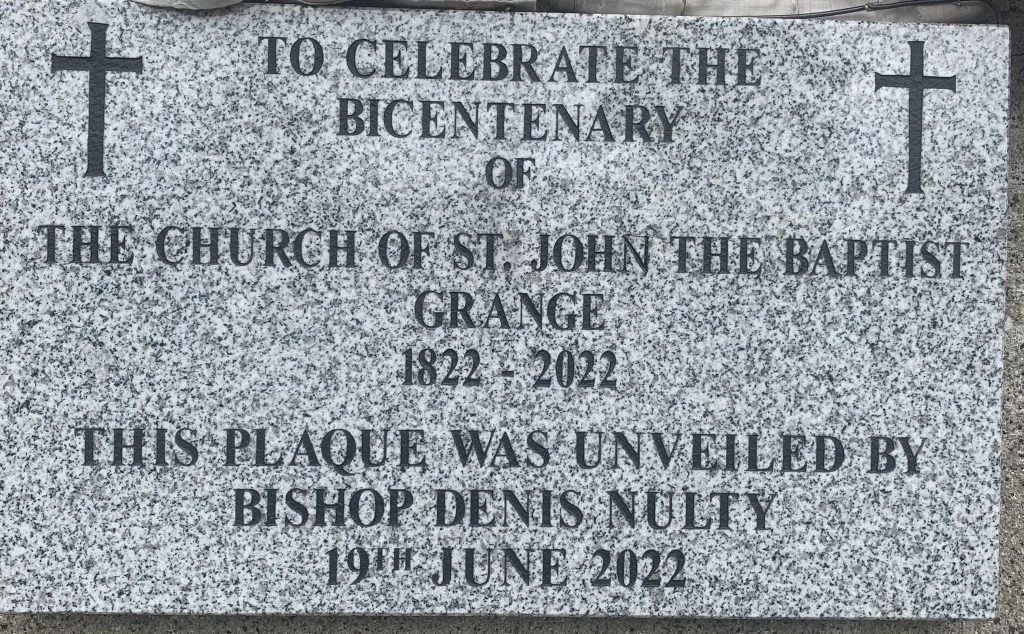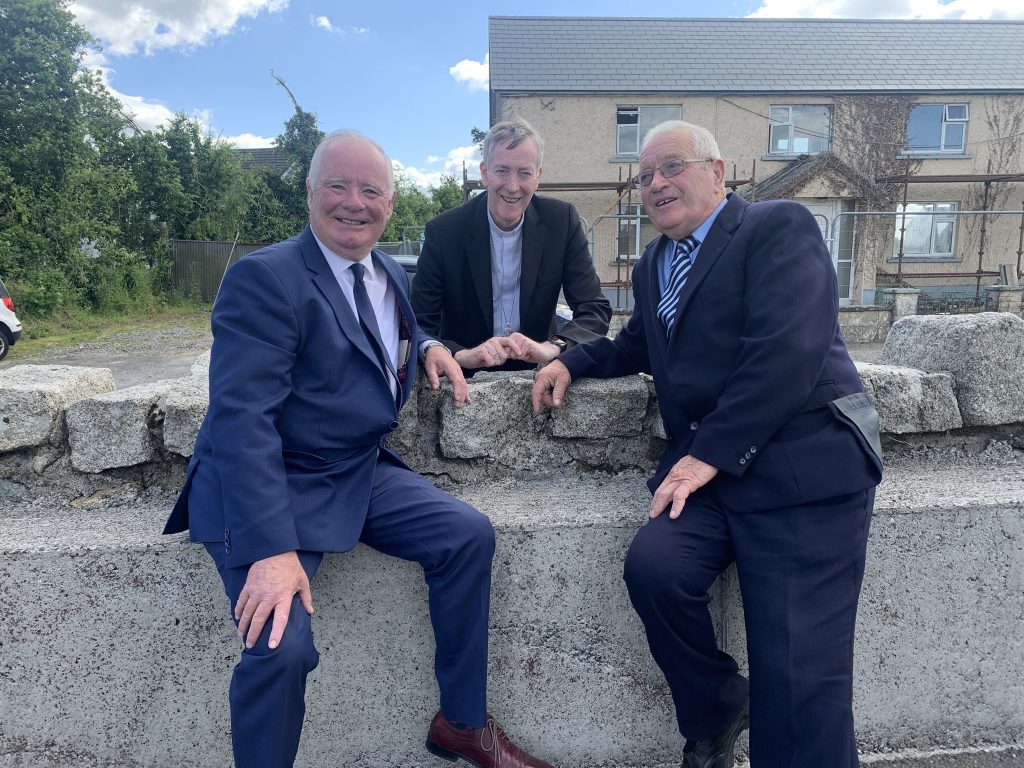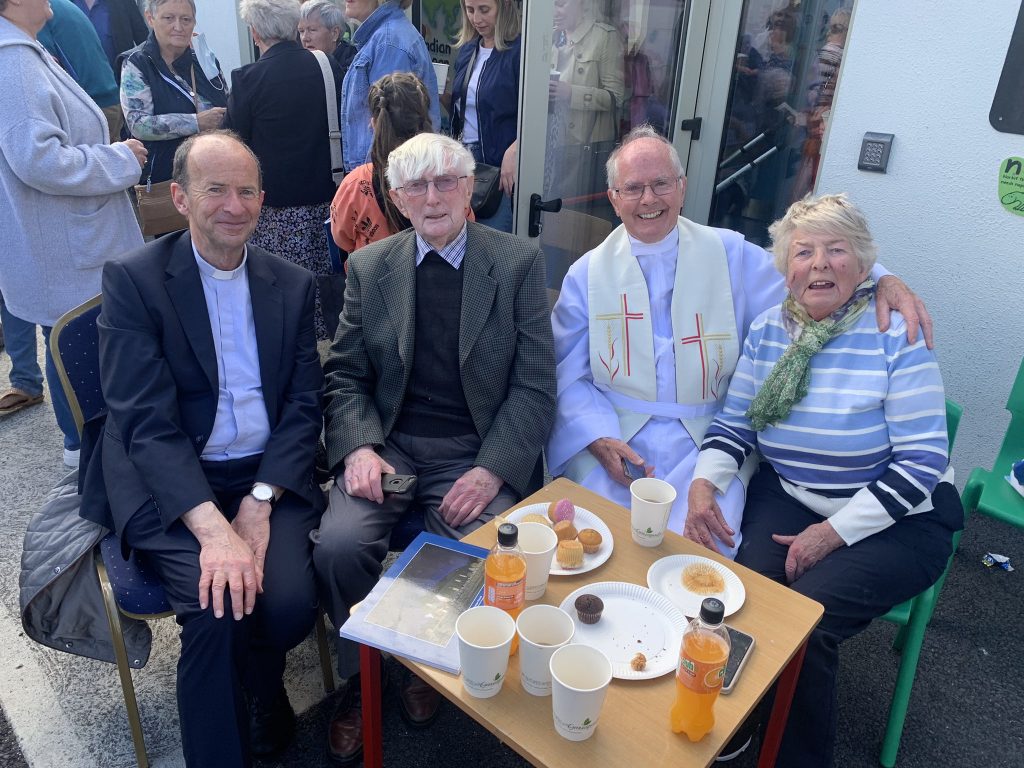Introduction:
It’s an absolute joy to be here this Sunday afternoon to mark the bicentenary of St. John the Baptist Church in Grange. We gather outside the Church, for the simple reason the Church could not even attempt to accommodate the numbers who are here. The oudoor plan is months in gestation. An article in the Carlow Nationalist nine weeks ago clearly then, the expressed intention that this “event will be held outdoors”[1]. Fr. Brian and his bicentenary team are obviously good at long range weather forecasting!
Purposefully they have arranged the outdoor altar and seating to be in the environs of the church, this is not a Cemetery Mass, the cemetery will have its own occasion on July 29th. This afternoon we honour Grange Church dedicated to St. John the Baptist. The cemetery is of course hugging the church, the school is over the way, and the homes are all around. Today is more than the bicentenary of a church we affectionately know as ‘Grange’, it is the bicentenary of a community – the living and the dead who have made Grange what it is today. I warmly welcome the priests who join with me, all with close associations to Grange and Tullow. I welcome all of you, conscious there are many parishioners who have close sacramental ties here and who are back for this bicentenary event.
It is Corpus Christi, the Feast of the Body & Blood of Christ. What a beautiful feast, that celebrates the foundation of our faith, to honour a church and a community. Last evening I was in Tullow for the 239th Corpus Christi Procession, initiated by Bishop Daniel Delany in 1783. Of course our own processions at every Mass to receive are of equal importance. No canopy, no candles just someone who needs the Eucharist to sustain their lives. Five loaves, two fish was all that was needed that afternoon two thousand years ago, and that’s all that’s required this afternoon. We complicate things. Let’s pause a moment and pray for God’s love, grace and mercy …
Homily:
If you put ‘Grange’ into your satnav or google maps app you would never arrive here today, because there is no such address as Grange, Tullow! The only places associated with the name ‘Grange’ are the church, the school, the football club and the cemetery. And yet ‘Grange’ is so close to the heart of this community and all of us who gather this afternoon.
I am very conscious that todays celebration is the third in a number of local churches marking bicentenaries in recent times. I think of St. Fintan’s Church in Ballinabranna, where we marked the bicentenary just before the pandemic lockdown. I think of Holy Cross Church in Killeshin where we marked its bicentenary last month.
Jimmy O’Toole has done all of us a great service with his new publication ‘The Bicentenary of Grange Church 1822-2022’. In it he writes vividly about the Grange area of 1819 when Fr. John P. Clancy took over pastoral care of the area. I quote: “a majority of the people were described as ‘poor and mostly illiterate’. According to local newspapers of the period a quarter of the population were paupers, meaning they were living in the most terrible of conditions …”[2]. Historian Shay Kinsella also captures the scene the builders looked on as these churches were built two hundred years ago: “had they raised their heads to survey the surrounding countryside, they would have seen little beyond the odd thatched cottage, poor mud tracks for roads and small fields of poorly-drained yet fertile land”[3].
I’ve mentioned John P. Clancy. If you look over the door you’ll see the initials ‘J.P.C.’ are carved and the mural plaque in his memory on the left wall of the nave of the church, corresponding to his place of burial within the church. Fr. Clancy was a Patrician Brother whom Bishop Daniel Delaney ordained initially to offer pastoral service to the Patrician Brothers. Later his sucessor JKL was the one responsible for assigning Fr. Clancy to Grange. He is the one remembered as the builder of the church and the school here at Grange. While some gravestones predate the church, Jimmy O’Toole contends “they were buried elsewhere and when plots were acquired later in Grange they were remembered on the inscriptions”[4].
The school opened on 1st May 1823. The teachers both appointed by Fr. Clancy were James Holligan and James Walsh. Hooligan was 35, Walsh was 19. Brenan writing in ‘The Schools of Kildare & Leighlin AD 1775-1835’ suggests “neither of them were very competent”[5]. The school was held then in the church. On the rolls there were 70 boys and 30 girls, 97 of them Roman Catholic.
In a bicentenary celebration we are honouring history etched in stone. I mentioned the three churches all celebrating bicentenaries in recent times – Ballinabranna, Killeshin and Grange. It was then the decade of Catholic Emancipation. Among the headstones surrounding our church here was a slab honouring Jane Hanlon, she was the daughter of the Duke of Wellington who was the British Prime Minister when Catholic Emancipation was enacted.
In 2029 we will honour the bicentenary of Catholic Emancipation. Dermot McCarthy speaking at a Synodal gathering in Athlone yesterday suggested “maybe today Ireland is experiencing a second emancipation, this time from a national identity almost dependent on catholic culture, to one suspicious and often intolerant of its Catholic inheritance”[6]. Grange, I suggest is a crossroads, not found on any satnav or google maps, a crossroads where the church, the club, the school, the cemetery all intersect.
And maybe Ireland and our Church are also at that crossroads where our Synodal pathway will bring us. A pathway where all feel welcome, included and involved but equally one which is defined by clear good adult faith formation to build on what we all receive in our school days. We always need more. And I pray the Holy Spirit will guide us on the journey towards that crossrroads.
How do we find this crossroads? The contours are certainly on no map. It was no mistake that Jesus chose fishermen as his first disciples. A Brazilian fisherman, when asked why, suggests “People who travel on the land build roads, and they continue to use these roads over and over again. But a fisherman goes searching for the fish wherever they are. And so he chooses a different path each day. For it happens that yesterdays route doesn’t lead to tomorrow’s catch”.
The taberbnacle door in my Prayer Room at Bishop’s House is a piece of art by local artist Anne Murphy of Eala Enamels, depicting the three loaves and the two fish. It reminds me I must always launch out, like those early disciples into the deep. The five loaves and two fish are all that is required. We complicate the picture; we nuance the message, all that’s needed is five loaves and two fish!
The young people from St. Brigid’s NS Grange wrote letters to me before their Confirmation with Fr. Brian earlier this year. I love reading their letters. I often think the young boy[7] who had the two fish and the few loaves in John’s gospel could be any one of them. Daragh[8] told me of how the “younger kids look up to me and my friends” and how “the past two years have been tearing our world apart … in lockdown me and my dad went camping in the woods”. Amy[9] told me she had “a cat called Honey, and three hens named Pennie, Marmalade and Dusty” and she suggested the diocese could run family fun days and they “could be advertised on platforms like tik tok”.
There was no conception of tik tok 200 years ago! Who knows what the world will be like in twenty years time, not to mention 200? But community is critical and will always remain so. The young people were happy to return to school after lockdown, they missed their friends. The crossroads at Grange will always be a place where people gather, where people remember and where people celebrate. Google may not have heard of it, but locals know it very well! On afternoons like this we give thanks to those who put the first peg on this crossroad, the church. ‘Grange’ is much more than bricks and mortar, it will always be the crossroads where the community gathers, the church, the cemetery, the club, the school. And remember it only takes five loaves and two fish, to nourish us this day and every day.



[1] Pender, Suzanne, The Nationalist, “Special event in June will mark the 200th Anniversary of Grange Church”, 12 April 2022, pg. 10.
[2] O’Toole, Jimmy, ‘The Bicentenary of Grange Church 1822-2022’, Grange Bicentenary Committee, 2022, pg. 12.
[3] Kinsella, Shay: ‘St. Fintan’s Church, Ballinabranna, Co. Carlow – A Short History’, Mochua Print, February 2020, pg. 5
[4] O’Toole, Jimmy, ‘The Bicentenary of Grange Church 1822-2022’, Grange Bicentenary Committee, 2022, pg. 25.
[5] Brenan, Martin: ‘Schools of Kildare & Leighlin A.D. 1775-1835’, Gill & Son, 1935, pg. 603
[6] McCarthy, Dermot: ‘Context for developing a Synodal Church’, Athlone Synodal Assembly, 18 June 2022
[7] Jn.6:9
[8] Daragh O’Shea, letters acknowledged 30 March 2022
[9] Amy Lawlor, letters acknowledged 30 March 2022